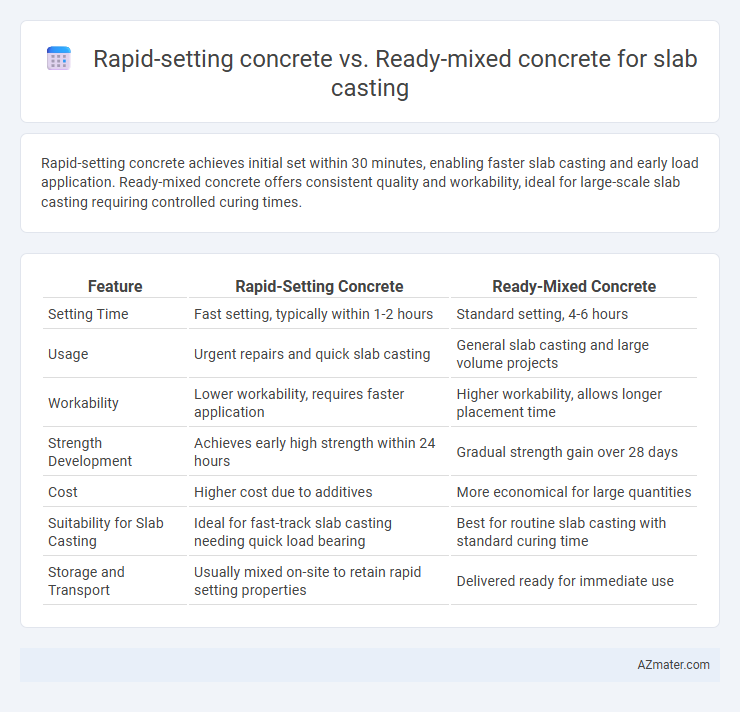Rapid-setting concrete achieves initial set within 30 minutes, enabling faster slab casting and early load application. Ready-mixed concrete offers consistent quality and workability, ideal for large-scale slab casting requiring controlled curing times.
Table of Comparison
| Feature | Rapid-Setting Concrete | Ready-Mixed Concrete |
|---|---|---|
| Setting Time | Fast setting, typically within 1-2 hours | Standard setting, 4-6 hours |
| Usage | Urgent repairs and quick slab casting | General slab casting and large volume projects |
| Workability | Lower workability, requires faster application | Higher workability, allows longer placement time |
| Strength Development | Achieves early high strength within 24 hours | Gradual strength gain over 28 days |
| Cost | Higher cost due to additives | More economical for large quantities |
| Suitability for Slab Casting | Ideal for fast-track slab casting needing quick load bearing | Best for routine slab casting with standard curing time |
| Storage and Transport | Usually mixed on-site to retain rapid setting properties | Delivered ready for immediate use |
Understanding Rapid-Setting Concrete: Key Features
Rapid-setting concrete achieves high early strength within hours due to its specialized chemical admixtures like calcium aluminate cement, making it ideal for time-sensitive slab casting projects. This concrete type reduces curing time dramatically compared to ready-mixed concrete, which typically requires 24-48 hours to gain sufficient strength. Its key features include accelerated hydration, improved durability under rapid loading, and enhanced resistance to thermal cracking during slab construction.
Overview of Ready-Mixed Concrete for Slab Casting
Ready-mixed concrete for slab casting is pre-mixed at batching plants to ensure precise control over material quality and consistency, resulting in high strength and durability. It offers the advantage of rapid delivery and ease of placement, reducing labor costs and construction time on site. This type of concrete is ideal for large-scale projects requiring uniform slabs with optimal structural performance and surface finish.
Speed of Construction: Rapid vs Ready-Mixed Concrete
Rapid-setting concrete significantly accelerates slab casting by achieving initial set within 20 to 40 minutes, allowing formwork removal and subsequent construction activities to proceed much faster than with ready-mixed concrete, which typically sets in 4 to 6 hours. This speed advantage reduces overall project timelines and labor costs, making rapid-setting concrete ideal for time-sensitive projects. However, ready-mixed concrete offers consistent quality and workability suitable for larger slab areas where extended setting time facilitates finishing and adjustments.
Strength Development: Performance Differences
Rapid-setting concrete achieves high early strength, often reaching 2000 psi within 3 hours, making it ideal for fast turnaround slab casting where quick load application is necessary. Ready-mixed concrete develops strength more gradually, typically achieving 3000 to 4000 psi at 28 days, providing long-term durability and structural integrity for slabs. The accelerated hydration kinetics in rapid-setting mixes contrast with the controlled curing process in ready-mixed concrete, impacting final strength profiles and project scheduling decisions.
Workability and Placement Considerations
Rapid-setting concrete offers faster setting times and early strength development, making it ideal for projects requiring quick turnaround, though its workability window is shorter and demands precise timing during placement. Ready-mixed concrete provides extended workability and uniform consistency, allowing for easier handling and placement in slab casting, particularly beneficial for large-scale pours or complex formwork. Both types require careful moisture and temperature control, but rapid-setting concrete necessitates more immediate finishing techniques to prevent defects.
Durability Comparison for Long-Term Use
Rapid-setting concrete cures quickly, allowing for faster slab casting but may exhibit slightly reduced long-term durability compared to ready-mixed concrete due to its lower water-cement ratio and rapid hydration process. Ready-mixed concrete offers superior long-term durability for slab applications, attributed to its controlled mix design, optimal curing conditions, and consistent quality control during production, resulting in enhanced resistance to weathering, abrasion, and chemical attack. For long-term use, ready-mixed concrete slabs demonstrate greater structural integrity and lifespan, making them more suitable for demanding environments despite the longer setting time.
Cost Analysis: Rapid-Setting vs Ready-Mixed Concrete
Rapid-setting concrete typically incurs higher material costs due to specialized admixtures but reduces labor and downtime expenses by enabling faster slab casting and early load application. Ready-mixed concrete offers lower initial costs and consistent factory-produced quality but may increase overall project costs through longer curing times and extended formwork usage. Evaluating project timelines and labor rates is crucial in determining cost-effectiveness between rapid-setting and ready-mixed concrete for slab casting.
Curing Requirements for Each Concrete Type
Rapid-setting concrete requires accelerated curing methods such as steam curing or the application of curing compounds to achieve early strength within hours, making it ideal for fast-track slab casting. Ready-mixed concrete demands a longer moist curing period of at least 7 days, maintaining humidity and temperature to ensure proper hydration and strength development. Proper adherence to curing protocols for each type significantly affects the durability and performance of the slab.
Best Applications: When to Use Each Option
Rapid-setting concrete is ideal for slab casting in situations requiring quick turnaround times, such as emergency repairs, road patches, or cold weather conditions, because it gains strength within hours and minimizes downtime. Ready-mixed concrete suits large-scale slab projects needing uniform consistency and controlled mix quality, like commercial floors and residential slabs, where extended working time and high durability are essential. Choosing between these options depends on balancing speed and performance demands with project size and environmental factors.
Environmental Impact and Sustainability Factors
Rapid-setting concrete reduces curing time, minimizing construction delays and lowering energy consumption at job sites, contributing to a smaller carbon footprint compared to traditional ready-mixed concrete. Ready-mixed concrete involves extensive transportation and batching processes, increasing fuel emissions and resource usage, whereas rapid-setting formulations often incorporate supplementary cementitious materials such as fly ash or slag to enhance sustainability. Choosing rapid-setting concrete for slab casting promotes efficient material usage and waste reduction, aligning with green building certifications and sustainable construction practices.

Infographic: Rapid-setting concrete vs Ready-mixed concrete for Slab casting
 azmater.com
azmater.com